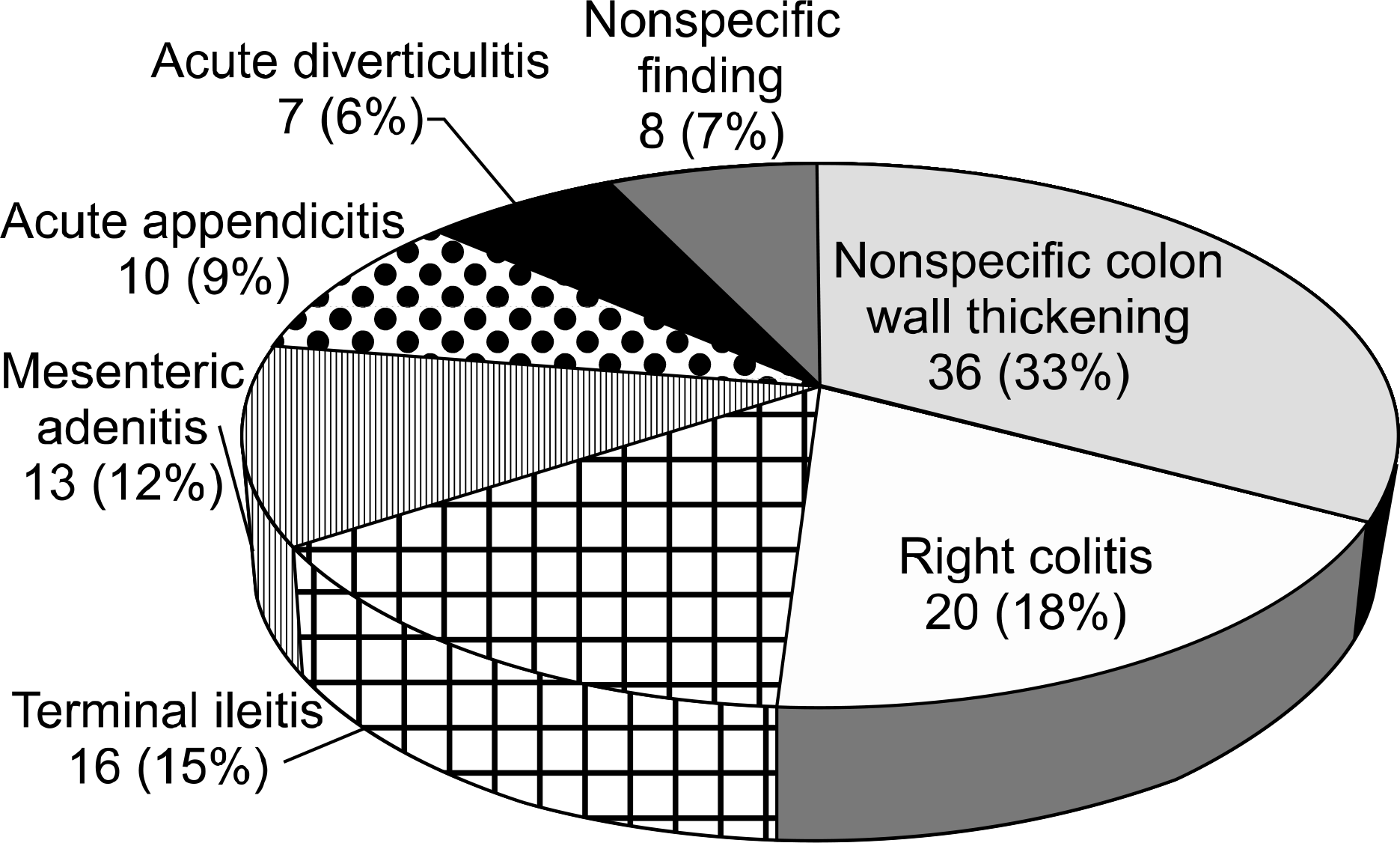Abstract
Background/Aims
Clinical manifestations of intestinal yersiniosis include enterocolitis, mesenteric adenitis, and terminal ileitis presenting with fever, right lower quadrant pain, and leukocytosis. According to a previous Korean study in 1997, Yersinia was revealed in two among 15 adult patients with mesenteric adenitis (13%). However, recent reports on the prevalence of Yersinia infection in adult patients are few. The aim of this study was to investigate the prevalence of Yersinia infection in adult patients with acute right lower quadrant pain.
Methods
Adult patients (>18 years) who visited Eulji medical center, due to acute right lower quadrant pain were enrolled prospectively from December 2007 to July 2009. Abdominal CT, stool culture, serologic test for Yersinia, and Widal test were performed.
Results
Among 115 patients, 5 patients were excluded due to positive Widal test or salmonella culture. In 110 patients, abdominal CT showed right colitis in 20 (18.2%), terminal ileitis in 16 (14.5%), mesenteric adenitis in 13 (11.8%), acute appendicitis in 10 (9.1%), acute diverticulitis in 7 (6.4%), non specific mucosal edema in 36 (32.7%) and no specific lesion in 8 (7.3%). Two (1.8%) of the 110 patients had antibodies to Yersinia. One patient showed acute enteritis and the other patient was diagnosed with acute appendicitis and underwent appendectomy. No Yersinia species were grown on stool or tissue culture.
Go to : 
References
1. Bockemühl J, Roggentin P. Intestinal yersiniosis. Clinical importance, epidemiology, diagnosis, and prevention. Bundesgesundheitsblatt Gesundheitsforschung Gesund-heitsschutz. 2004; 47:685–691.
2. Stolk-Engelaar VM, Hoogkamp-Korstanje JA. Clinical presentation and diagnosis of gastrointestinal infections by Yersinia enterocolitica in 261 Dutch patients. Scand J Infect Dis. 1996; 28:571–575.
3. Lee JH, Rhee PL, Lee JK, et al. The etiology and clinical characteristics of mesenteric adenitis in Korean adults. J Korean Med Sci. 1997; 12:105–110.

4. Cho CR, Um TH, Paik IK. Comparative study for isolation of Yersinia pseudotuberculosis from water. Korean J Clin Microbiol. 2005; 8:136–141.
5. Paik IK, Cho CR, Goo JW, Kim EC. Yersinia pseudotuberculosis infection in northeastern part of Seoul. Korean J Infect Dis. 1994; 26:1–7.
6. Paik IK, Cho CR, Kim MA. Epidemiological investigation of Yersinia pseudotuberculosis infection in Korean. Korean J Clin Pathol. 1997; 17:1068–1075.
7. Son TJ, Kim DH, Jo YJ, et al. Is the Yersinia enterocolitica possible infectious agent in acute appendicitis? J Korean Surg Soc. 2009; 76:221–224.
8. Smego RA, Frean J, Koornhof HJ. Yersiniosis I. microbiological and clinicoepidemiological aspects of plague and non-plague Yersinia infections. Eur J Clin Microbiol Infect Dis. 1999; 18:1–15.
9. Bottone EJ. Yersinia enterocolitica: overview and epidemiologic correlates. Microbes Infect. 1999; 1:323–333.
10. Ljungberg P, Valtonen M, Harjola VP, Kaukoranta-Tolvanen SS, Vaara M. Report of four cases of Yersinia pseudotuberculosis septicemia and a literature review. Eur J Clin Microbiol Infect Dis. 1995; 14:804–810.
11. Bottone EJ. Yersinia enterocolitica: the charisma continues. Clin Microbiol Rev. 1997; 10:257–276.
12. Schiemann DA. Synthesis of a selective agar medium for Yersinia enterocolitica. Can J Microbiol. 1979; 25:1298–1304.
13. Cho CR, Oh HC, Paik IK. Agglutination tests for Yersinia pseudotuberculosis antibody. Korean J Clin Pathol. 1996; 16:681–688.
14. Naktin J, Beavis KG. Yersinia enterocolitica and Yersinia pseudotuberculosis. Clin Lab Med. 1999; 19:523–536.
15. Butler T. Yersinia infections: centennial of the discovery of the plague bacillus. Clin Infect Dis. 1994; 19:655–661.
Go to : 
Table 1.
Clinical Characteristics of Patients with Right Lower Quadrant Pain
Table 2.
Results of Yersinia Serum Antibody and Culture in 110 Patients with Right Lower Quadrant Pain
| Serum antibody (n=110) |
Yersinia culture |
||||
|---|---|---|---|---|---|
| Stool (n=55) | Tissue (n=20) | ||||
| Positive | 2 (1.8%) a | Positive | 0 | Positive | 0 |
| Negative | 108 (98.2%) | Negative | 55 | Negative | 20 |




 PDF
PDF ePub
ePub Citation
Citation Print
Print



 XML Download
XML Download